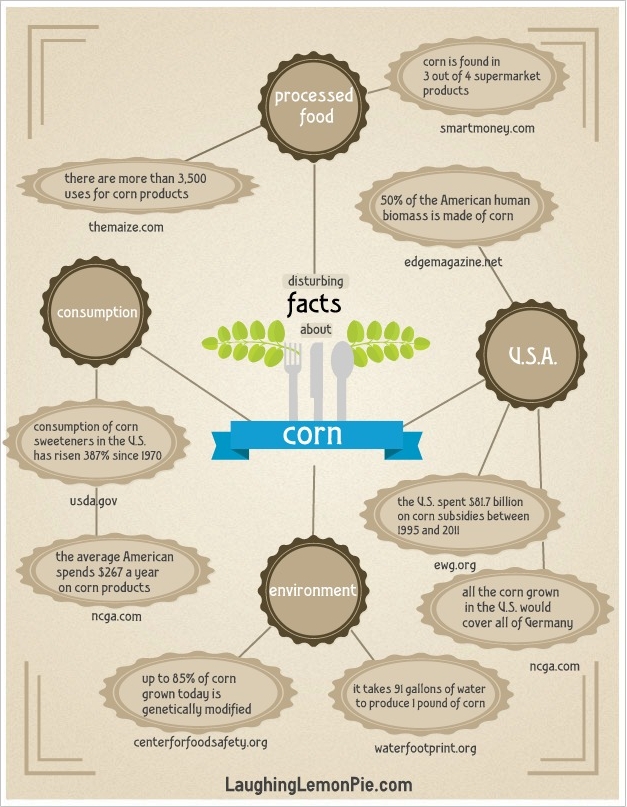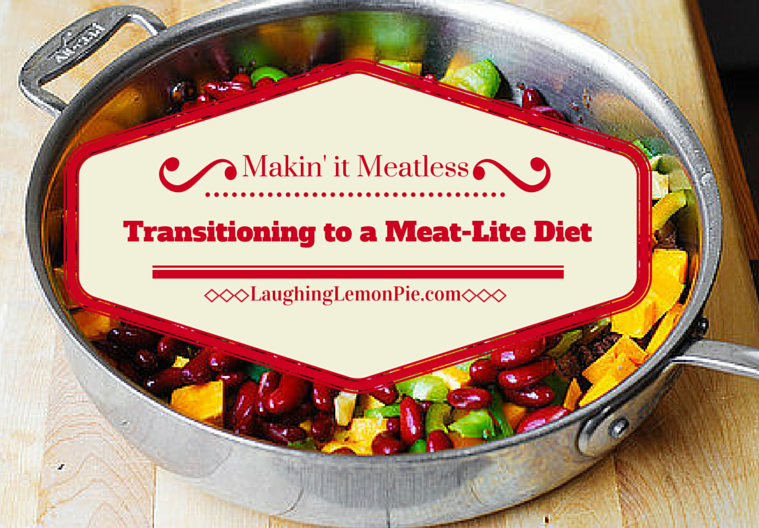Last week I told you to eat more corn—which could be a pretty controversial statement if you know anything about corn. I was hoping to give you a few reasons to eat more fresh corn now and preserve some for the future. I definitely wasn’t saying that you should eat more processed corn, because Sustainable Eating Tip No. 8 is…
Eat Less Processed Corn
And here’s why:
I made this nifty little infographic to illustrate just a FEW of the reasons you should avoid eating processed corn—which, basically, means avoiding processed food, because nearly all processed foods from bread to shredded cheese, has corn in it. Yup.
Want proof? Here are some of the many names corn can hid behind on nutrition labels:
- Dextrins
- Maltodextrins
- Dextrose
- Fructose or crystalline fructose
- Hydrol, treacle
- Ethanol
- Free fatty acids
- Maize
- Zein
- Sorbitol
As you can see, even if it doesn’t have the word “corn” in it, it might still have corn in it. If that makes any sense! Check out this extensive list of products that may contain corn from the University of Rochester Medical Center.
Why is corn in processed food a problem?
So why does it matter that all these foods contain corn products or byproducts?
First, despite all evidence to the contrary based on how much of the stuff we farm, corn is kind of a tricky crop to grow. It requires 91 gallons of water to grow one pound of corn. Planting, growing, and harvesting one acre of corn uses 140 gallons of fossil fuels. Plus, it needs a lot of fertilizer, pesticide, and herbicide to make an acre of corn produce the way modern farmers want it to produce—which pollutes the soil and the water table.
Lots of corn is grown to make ethanol, an additive in gasoline in the US. But studies have shown that it actually uses more energy to grow the corn than is produced by burning ethanol—almost 70 percent more!
Nearly 80 percent of the corn grown in the U.S. is used to feed livestock, including cows, pigs and chickens. But cows in particular did not evolve to eat corn (they evolved to eat grass), and eating corn actually makes the cows sick, requiring that they be constantly dosed with antibiotics—which then gets into the meat and the milk.
And that hasn’t even touched on the health effects of corn on humans. All of those corn byproducts above, as well as high fructose corn syrup, have changed the way we humans in America eat. In fact, because of corn’s unique carbon signature, you can actually do tests to see how much of your body is made up of corn—and for the average American, it’s about 50 percent. That’s right: you’re 50 percent corn.
Part of the reason there is so much corn in processed food products is that corn is cheap. The US subsidizes corn keeping the price artificially low. Because of the subsidy payments, lots of American farmers grow lots and lots of corn. The food industry has gotten very, very good at finding ways to use up all that cheap corn—many times in place of more expensive (and possibly healthier) ingredients.
And while there was a scare recently about consuming high fructose corn syrup, the actual research says that consuming too much of any high sugar food is bad for you. The fact remains, however, that we have cheap, easy access to high fructose corn syrup in lots of processed foods and drinks, and that ease of access is the major problem.
Are you starting to get the picture?
The bad news is, it requires superhuman feats to avoid all corn in your diet—just ask anyone who has a corn allergy. Corn is in practically EVERYTHING from your hamburger to the corn oil your french fries were fried in. Even some of your cosmetics and over the counter drugs like acetaminophen have corn in them. The producers of the film King Corn tried to go corn-free for a month, and found it nearly impossible to do. Still, I’ve got a few suggestions:
5 ways to reduce the amount of corn you eat:
- Avoid processed food.
It’s not a fun tip, but it’s a realistic one: the closer a food is to its original source, the less corn it will have in it. (Unless it’s corn on the cob!) - Eat grass-fed meats.
Corn fed meats are bad for a myriad of reasons, so you’re better off going grass-fed anyway. - Avoid high fructose corn syrup.
When you do reach for processed foods like sodas, candy and baked goods, look for ones that don’t use high fructose corn syrup. The jury is still out about the health effects of HFCS as compared to regular sugar, but avoiding it can’t do you any harm. - Pay attention to oils.
Corn oil is one of the biggest uses of corn in the US, and it’s used to fry all kinds of things. Open your eyes and ask your waiter what kinds of oils are used in the restaurant’s kitchen. - Learn to decode the many names of corn.
The list above is a good place to start and will help you identify corn masquerading as one of the 3,500+ different products food producers use.
I’m challenging myself to eat more sustainably over the next year—and documenting the steps I take in this series, inspired by an article in the Jul/Aug 2010 issue of Whole Living Magazine. Want to join me? Leave a comment below and pledge to eat more sustainably this year!






One thought on “5 Ways to Eat Less Processed Corn (And Why You Should) {Budget Organic No. 8}”